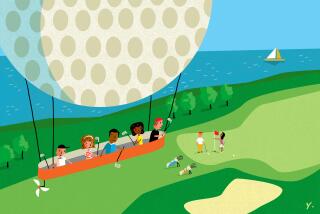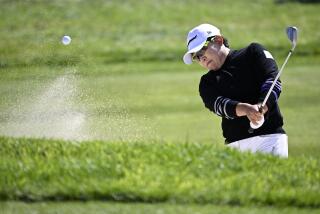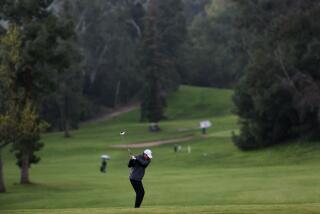TEEING IT UP IS TORTURE IN THE DESERT : The Skins Game Foursome Will Confront the Toughest Golf Course in the Country
- Share via
LA QUINTA, Calif. — The first thing you need to know about the PGA West Stadium course is that it is rated the most difficult golf course in the country by the United States Golf Assn.
Created by golf architect Pete Dye in a desert wasteland 30 miles southeast of Palm Springs, the Stadium course is 7,271 yards long and plays to a par 72. According to the USGA handicap committee, however, it is more than five shots harder than that. Ratings are supposed to be the measure of how a scratch handicap golfer would score on a course. At PGA West he is projected to shoot 77.1.
Riviera Country Club, site of a U.S. Open and PGA tournament, home of the Los Angeles Open and everybody’s choice as one of the country’s top 25 courses, is rated 74.8. Los Angeles North, called by some golfers the most difficult course in Greater Los Angeles, is rated 74.5.
The second-highest rated course in the country is the Oak Tree Golf Club in Edmond, Okla. It is rated 76.8. It was also designed by Dye. It is also owned by the Landmark Land Co., builders of the PGA West complex.
The story is that Ernie Vossler and Joe Walser Jr., founders of the Landmark golf communities in California, Oklahoma and Louisiana, told Dye to make the toughest golf course he could. “Make it tougher than Oak Tree, tougher than TPC (another of Dye’s creations), tougher than anything in the country.”
So he did. He designed 18 holes that can stretch from 5,228 yards for the women to 7,721 for the professionals, with more water than fairways and more sand than greens. Pot bunkers, 200-yard sand traps, 8 lakes, 5,000 railroad ties and more than 250,000 hand-planted shrubs make it a diabolical golfing torture chamber. Water must be crossed on nine holes.
Jack Nicklaus, Arnold Palmer, Fuzzy Zoeller and Lee Trevino will play the Skins Game here this weekend, nine holes Saturday and nine holes Sunday, giving the course its first national TV exposure. They will be playing for $450,000, with single holes worth $35,000 or more. They’ll earn it.
The course will be shortened slightly, to about 7,000 yards, for the made-for-NBC-TV event.
Shortening a hole means only that the players will have an opportunity to find trouble with a shorter club. For instance, one hole that will be cut down is No. 6, a 255-yard carry over a lake, one of the longest par-3 holes anywhere. When Nicklaus, Palmer, Zoeller and Trevino reach it Saturday, the hole will probably be “only” 235 yards.
That is still 13 yards longer than No. 16 at Cypress Point, the across-the-ocean hole that is often called the toughest hole on the PGA tour. The Pacific Ocean may be more intimidating but it’s no wetter than the lakes of PGA West.
The sixth hole was selected by the PGA as the most difficult No. 6 in the country.
“If the wind is in their face, even our longest hitters and tour players can’t carry it from the back tees,” says head professional Jay Colliatie. “It’s a long, long hole.”
The ninth hole, a par-4 of 450 yards, was named by Golf magazine as one of the country’s greatest 100 holes. Not most difficult, just one of the greatest.
“A great golf hole is a great course in microcosm--challenging, flexible, well balanced, beautiful and above all, inspiring to play,” wrote Tom Doak in Golf.
No. 9 meets all those criteria. It is particularly beautiful with the purple shadows of the Santa Rosa Mountains as a backdrop for a hole that calls for two shots over water into a tiny green protected by huge bunkers fore and aft.
Each of the 18 holes has been given a name and those names give an indication of the penal quality of the course, such as Double Trouble, Black Hole, Craters, Moat, Cavern, San Andreas Fault and the real mind boggler, Alcatraz.
How difficult really is the Stadium course?
A story making the rounds in the locker rooms here in the desert perhaps tells it best:
Frank Morey, head professional at the Wilshire Country Club, has a home that borders the 14th fairway. As the story goes, Morey was playing PGA West when he reached No. 14, but the last golf ball in his bag had found a watery grave on No. 13.
“I might as well buy this place here,” he supposedly said. “I’m out of golf balls. I can’t go any farther.”
Dye became No. 1 on the pros’ hate list when he unveiled the Tournament Players Club course in Ponte Vedra, Fla., a few years ago, a course so difficult that the players demanded of Commissioner Deane Beman that Dye tone it down. Most of them haven’t seen PGA West yet, but they will get an opportunity when the club holds next year’s Bob Hope Classic.
Steve Walser, director of golf for PGA West, does not believe that the course, despite its growing reputation, is as difficult as the Oak Tree course in Oklahoma.
“Oak Tree is a par 71, so its handicap of 76.8 means it is probably tougher to shoot par than it is here,” he said. Walser should know. He came to PGA West from Oak Tree.
The course, which opened last Jan. 4, took a year and a half to plan and another year to finish construction. Dye even went to such extremes as staining the rocks used for 150-yard markers to match the colors of the nearby mountains.
Of PGA West, Dye says: “It has all the ingredients that I feel are necessary for a great golf course--natural beauty, shot value and mental replay.”
The course record is a five-under-par 67 by touring pro Fred Couples, one of the game’s longest hitters, and James Blair III, a club professional from Layton, Utah, who did it in the PGA Club Professional tournament. The record from the blue tees, which measure 6,821 yards, is 64 by Rick Ewing, a former Bakersfield amateur champion who is a member at PGA West.
In the course’s first tournament test, for PGA club pros last month, Bob Lendzion of Quechee, Vt., won by shooting a pair of 71s on the Stadium course. He edged Dana Quigley of Barrington, R.I., by a stroke with a bogey on the final hole after Quigley had made a double bogey.
Blair, after his record-equaling 67, took a 79 the second time around.
When Danny Edwards, one of Landmark’s bank of touring professionals, heard that the course would be used in the Hope tournament, he said, “I don’t think some of those amateurs will be able to get around in less than six hours.”
That is because Dye’s course, from any length, is too penal for the average golfer. Even from the white tees, which make it 6,313 yards, the fairway bunkers, pot holes and lakes still come into play.
The Stadium course is one of five in Landmark’s master plan for the 2,000 acres of agricultural land the company acquired between La Quinta and Indio. Three will be private--the Arnold Palmer course which opened last month, and two more are in the planning stages. The fifth will be a resort course designed by Nicklaus and scheduled to open in January of 1988. Nicklaus is also designing one of the private courses.
It may be easy to get frustrated here but it is not cheap. A lifetime membership in PGA West costs $50,000, but you also must be a PGA West home owner. An 18-hole round costs $100, if you can get a starting time.
How the PGA West Stadium course plays from the black, or tournament, tees:
No. 1 (440 yards, par 4)--Standing on the first tee, it looks inviting, but tee shots that stray to the left can be hazardous to your score. Fairway bunkers about 225 yards off the tee await wayward drives. The green is quite small for such a long hole, making it difficult to get home in two shots.
No. 2 (373 yards, par 4)--The name of the hole, Craters, tells the story. Alan Shepard would feel right at home hitting from the right side of the fairway. It looks like a moonscape. The green is 42 feet deep, with a hump in the front that makes it a definite 3-putt possibility.
No. 3 (470 yards, par 4)--The rules of golf say that no par 4 should be more than 470 yards. This stretches it to the limit and to make it worse, the wind is usually in your face. A huge bunker guards the green, and crescent-shaped traps on the left make it a difficult driving hole.
No. 4 (184 yards, par 3)--If the hole is 184 yards, the sand trap down the right side has to be 160 yards. The left side of a medium-sized green is also protected by two traps, giving the entire hole the feeling that it’s something out of “Lawrence of Arabia.”
No. 5 (533 yards, par 5)--The scorecard says this is the shortest par-5, but the handicap indicates that it is the toughest hole on the course. It is No. 1. Unless you hit a straight drive, it’ll get you on either side. A lake on the left will catch those who hook their drives and a pond to the right of the green will catch the faders on their approach shots.
No. 6 (255 yards, par 3)--One of the longest par-3 holes in the country is not enough. It calls for a full carry over water with only a tiny area to the left where short hitters--or the faint hearted--can bail out. Any tee shot that leaks right is going to get wet. Also frustrating are 250-yard tee shots that would be perfect on any other hole, but here they smack into railroad-tie bulwarks and splash in the water. The largest green on the course helps, but not much. Three levels can frustrate the best of putters.
No. 7 (350 yards, par 4)--More water, more bunkers and higher-than-your head pot bunkers make it a deceiving 350 yards. Tee shots must be accurately placed, 200 yards out, to find the landing area. Short iron shots to the green cannot stray left where bunkers and the Black Hole, an enormous pot bunker, can send scores soaring. Pete Dye calls it the most picturesque hole of the 18.
No. 8 (557 yards, par 5)--For the big hitters, this would normally be a get-home-in-two opportunity, but the fairway is extremely narrow, lined on both sides by bunkers. Another huge trap looms in front of the green, eliminating the possibility of bouncing a second shot on the green.
No. 9 (450 yards, par 4)--If you have to hit a hook, this is the place. The entire right side of the hole is water and sand. Even a perfect tee shot down the left side will set up an approach shot with a long iron over a neck of the lake to a green on the small side. The name of this hole is Reflection, but you don’t want to see your reflection while looking for a ball.
No. 10 (414 yards, par 4)--When you see a rock-lined lake on the left, the prudent thing usually is to hit your tee shot out to the right. Not here. Waiting on the right are bunkers, deep ones, that supposedly give the hole character. The largest of eight lakes runs the length of the left side.
No. 11 (618 yards, par 5)--The longest hole on the course is well named: Eternity. If distance alone isn’t enough, there are bunkers waiting to snare tee shots and the fairway slopes from right to left, sending balls skittering into the rough. Then, at the end, there is the ubiquitous water just off the left edge of the green.
No. 12 (360 yards, par 4)--For first-time players, this hole is extremely testing because second shots--to a blind green--must carry a deep, sand-filled moat. What can appear to be a fine approach shot can sometimes be found 10 feet deep in a moat with sides so steep that narrow, wooden steps are needed to get in and out of it.
No. 13 (230 yards, par 3)--If you can’t hit high shots over water, don’t come to PGA West. Another long par-3 calls for yet another shot across a lake that carries from tee to green. Balls hit to the right, to avoid a watery death, may land in a pesky bunker if short.
No. 14 (390 yards, par 4)--This is a deceptive hole, more difficult than its rating of 18 would make you believe. A trap runs nearly 200 yards down the right side and the green is the smallest on the course with sand in front and a deep cavern to the left and behind the green.
No. 15 (470 yards, par 4)--No water here, but fairway bunkers on both sides make it imperative to hit an accurate tee shot. A long second shot, usually into a prevailing breeze, must stay clear of more sand to the left of the green.
No. 16 (571 yards, par 5)--The most frustrating hole on the course. Drives, from an elevated tee, must avoid a steep embankment on the left that runs nearly the length of the hole. Approach shots that miss to the left call for a bunker shot almost straight up 19 feet to the green. When you’re down there, it looks more like 50 feet. Almost perfect shots can wind up down the cliff because there is only a couple of feet between the edge of the green and disaster.
No. 17 (166 yards, par 3)--Dye liked his No. 17 at the Tournament Players Club in the Florida swampland so much that he duplicated it here in the California desert. A tiny island green, only 14 by 19 yards, is surrounded by water and rocks. You have to know your yardage, especially when the wind is swirling. A tee shot must hit--and hold--the green or the shots start counting double because there is no place to lay up.
No. 18 (440 yards, par 5)--A great finishing hole, providing you have any golf balls left. The tee shot must carry at least 170 yards over water, and from there to the green there is more water all the way down the left side. The fairway is slightly uphill, making the second shot longer than it seems. A par here can win many a match. A bogey won the Club Professionals tournament.
More to Read
Go beyond the scoreboard
Get the latest on L.A.'s teams in the daily Sports Report newsletter.
You may occasionally receive promotional content from the Los Angeles Times.










